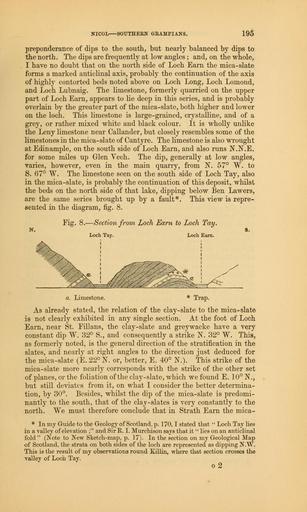MAKE A MEME
View Large Image

| View Original: | The_Quarterly_journal_of_the_Geological_Society_of_London_(12645732125).jpg (1225x2046) | |||
| Download: | Original | Medium | Small | Thumb |
| Courtesy of: | commons.wikimedia.org | More Like This | ||
| Keywords: The Quarterly journal of the Geological Society of London (12645732125).jpg NICOL SOTJTHEEN GEAMPIANS <br> 195 <br> preponderance of dips to the south but nearly balanced by dips to <br> the north The dips are frequently at low angles ; and on the whole <br> I have no doubt that on the north side of Loch Earn the mica-slate <br> forms a marked anticlinal axis probably the continuation of the axis <br> of highly contorted beds noted above on Loch Long Loch Lomond <br> and Loch Lubnaig The limestone formerly quarried on the upper <br> part of Loch Earn appears to lie deep in this series and is probably <br> overlain by the greater part of the mica-slate both higher and lower <br> on the loch This limestone is large-grained crystalline and of a <br> grey or rather mixed white and black colour It is wholly unlike <br> the Leny limestone near Callander but closely resembles some of the <br> limestones in the mica-slate of Cantyre The limestone is also wrought <br> at Edinample on the south side of Loch Earn and also runs N N E <br> for some miles up Glen Yech The dip generally at low angles <br> varies however even in the main quarry from N 57° W to <br> S 67° W The limestone seen on the south side of Loch Tay also <br> in the mica-slate is probably the continuation of this deposit whilst <br> the beds on the north side of that lake dipping below Ben Lawers <br> are the same series brought up by a fault This view is repre- <br> sented in the diagram fig 8 <br> n <br> Eig 8 ” Section from Loch Earn to Loch Tay <br> Loch Tay Loch Earn <br> a Limestone <br> Trap <br> As already stated the relation of the clay-slate to the mica-slate <br> is not clearly exhibited in any single section At the foot of Loch <br> Earn near St Fillans the clay-slate and greywacke have a very <br> constant dip W 32° S and consequently a strike N 32° W This <br> as formerly noted is the general direction of the stratification in the <br> slates and nearly at right angles to the direction just deduced for <br> the mica-slate E 22° N or better E 40° N This strike of the <br> mica-slate more nearly corresponds with the strike of the other set <br> of planes or the foliation of the clay-slate which we found E 10° N <br> but still deviates from it on what I consider the better determina- <br> tion by 30° Besides whilst the dip of the mica-slate is predomi- <br> nantly to the south that of the clay-slates is very constantly to the <br> north We must therefore conclude that in Strath Earn the mica- <br> In my Guide to the Geology of Scotland p 170 1 stated that Loch Tay lies <br> in a valley of elevation ; and Sir R I Murchison says that it lies on an anticlinal <br> fold Note to New Sketch-map p 17 In the section on my Geological Map <br> of Scotland the strata on both sides of the loch are represented as dipping N W <br> This is the result of my observations round Killin where that section crosses the <br> valley of Loch Tay <br> o2 35328156 109632 51125 Page 195 Text v 19 http //www biodiversitylibrary org/page/35328156 1863 Geological Society of London Biodiversity Heritage Library The Quarterly journal of the Geological Society of London v 19 1863 Geology Periodicals Smithsonian Libraries bhl page 35328156 dc identifier http //biodiversitylibrary org/page/35328156 smithsonian libraries Information field Flickr posted date ISOdate 2014-02-20 Check categories 2015 August 26 CC-BY-2 0 BioDivLibrary https //flickr com/photos/61021753 N02/12645732125 2015-08-27 11 00 48 cc-by-2 0 PD-old-70-1923 The Quarterly journal of the Geological Society of London 1863 Photos uploaded from Flickr by Fæ using a script | ||||